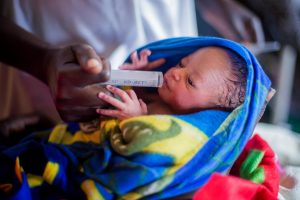
A nurse feeds the newborn child of Mary, 35, at the Nimule Hospital in Nimule, South Sudan. She gave birth to the twin outside the hospital but had an operation to deliver second twin. The second child had no chance at life, but the operation saved Mary’s. She now has 6 children including the new baby Mary says: “I have been coming to this hospital since 1994. All of my children have been delivered in this hospital. If it was not here there is nowhere else to go. If you need medical help you have to come here or you do not get proper treatment.” In South Sudan, giving birth with the right care and support is not something that can be taken for granted - the country has the highest maternal death rate in the world. That’s why facilities like Nimule Hospital, run by Save the Children, are so vital. They give women the chance to give birth in clean surroundings, with skilled birth attendants on hand to deal with complications.
Background
Complications of prematurity are the leading cause of deaths in children under the age of five. The predominant reason for these preterm deaths is respiratory distress syndrome (RDS). In low-income countries (LICs) there are limited treatment options for RDS. Due to their simplicity and affordability, low-cost bubble continuous positive airway pressure (bCPAP) devices have been introduced in neonatal units in LICs to treat RDS. This study is the first observational study from a LIC to compare outcomes of very-low-birth-weight (VLBW) neonates in pre- and post-CPAP periods.
Methods
This was a retrospective study of VLBW neonates (weight < 1500 g) in Mbale Regional Referral Hospital Neonatal Unit (MRRH-NNU), a government hospital in eastern Uganda. It aimed to measure the outcome of VLBW neonates in two distinct study periods: A 14-month period beginning at the opening of MRRH-NNU and covering the period until bCPAP was introduced (pre-bCPAP) and an 18-month period following the introduction of bCPAP (post-bCPAP). After the introduction of bCPAP, it was applied to preterm neonates with RDS when clinically indicated and if a device was available. Clinical features and outcomes of all neonates < 1500 g were compared before and after the introduction of bCPAP.
Results
The admission records of 377 VLBW neonates < 1500 g were obtained. One hundred fifty-eight were admitted in the pre-bCPAP period and 219 in the post-bCPAP period. The mortality rate in the pre- bCPAP period was 39.2% (62/158) compared with 26.5% (58/219, P = 0.012) in the post-bCPAP period. Overall, there was a 44% reduction in mortality (OR 0.56, 95%CI 0.36–0.86, P = 0.01). There were no differences in birthweight, sex, presence of signs of respiratory distress or apnoea between the two groups.
Conclusion
Specialized and resource-appropriate neonatal care, that appropriately addresses the challenges of healthcare provision in LICs, has the potential to reduce neonatal deaths. The use of a low-cost bCPAP to treat RDS in VLBW neonates resulted in a significant improvement in their survival in a neonatal unit in eastern Uganda. Since RDS is one of the leading causes of neonatal mortality, it is possible that this relatively simple and affordable intervention could have a huge impact on global neonatal mortality.